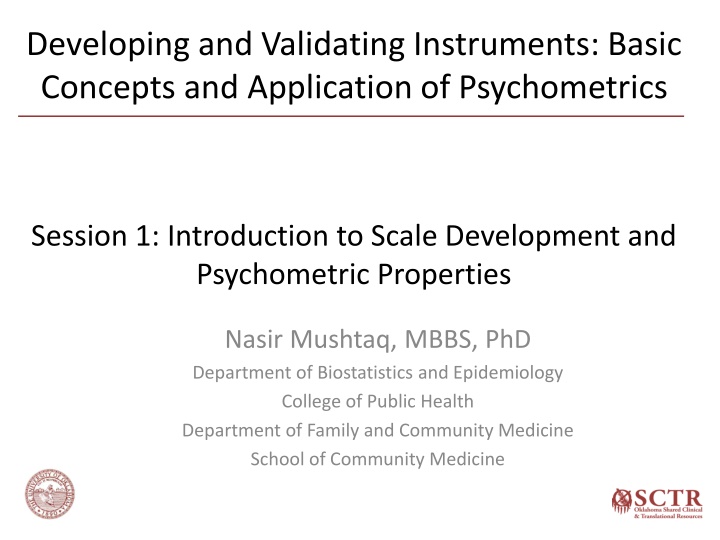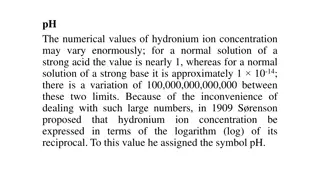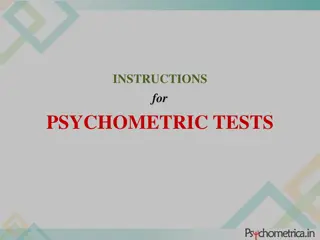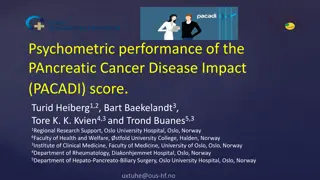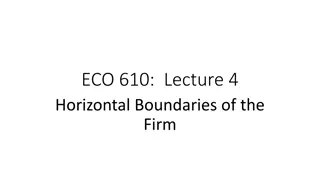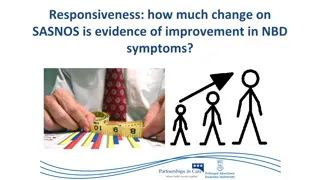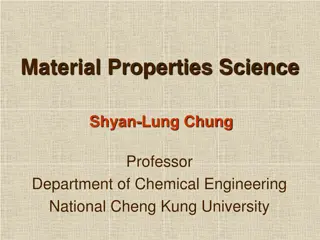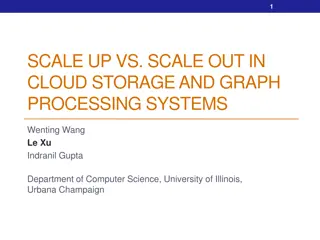Introduction to Scale Development and Psychometric Properties
Delve into the fundamental concepts of classical test theory, various validity and reliability types, essential scale development components, and the significance of psychometric analysis. Explore key terms, measurement methods, latent variables, scales, and components in developing and validating instruments.
Download Presentation

Please find below an Image/Link to download the presentation.
The content on the website is provided AS IS for your information and personal use only. It may not be sold, licensed, or shared on other websites without obtaining consent from the author.If you encounter any issues during the download, it is possible that the publisher has removed the file from their server.
You are allowed to download the files provided on this website for personal or commercial use, subject to the condition that they are used lawfully. All files are the property of their respective owners.
The content on the website is provided AS IS for your information and personal use only. It may not be sold, licensed, or shared on other websites without obtaining consent from the author.
E N D
Presentation Transcript
Developing and Validating Instruments: Basic Concepts and Application of Psychometrics Session 1: Introduction to Scale Development and Psychometric Properties Nasir Mushtaq, MBBS, PhD Department of Biostatistics and Epidemiology College of Public Health Department of Family and Community Medicine School of Community Medicine
Learning Objectives Describe basic concepts of classical test theory Describe different types of validity and reliability Discuss essential components of scale development Identify the role of psychometric analysis in scale development
Introduction Key Terms Measurement Instruments/Scales/Measures/ Assessment tools/Tests Latent Variable/Construct Psychometrics Reliability Validity
Measurement Methods used to provide quantitative descriptions of the extent to which individuals manifest or possess specified characteristics Assigning of numbers to individuals in a systematic way as a mean of representing properties of the individuals Measurement consist of rules for assigning symbols to objects so as to represent quantities of attributes numerically or define whether the objects fall in the same or different categories with respect to a given attribute (scaling or classification)
Latent Variable Latent variable or construct is a hypothetical variable you want to measure Not directly observable /objectively measure. A construct is given an operational definition based on a theory Measured with the observed variables responses obtained from the scale items
Scales Scale Measurement instrument Collection of items Items effect indicators Items of a scale share a common cause latent variable Goal is to quantitatively measure a theoretical construct X1 X1 X2 M L X2 X3 X3 Scale Index
Scales Components Items List of short statements or questions to measure the latent variable Response options Participants indicate the extent to which they agree or disagree with each statement by selecting a response on some rating scale Scoring Numeric values assigned to each item response Overall scale score is calculated
Psychometrics The art of imposing measurement and number upon operations of the mind (Sir Francis Galton, 1879) The branch of psychology that deals with the design, administration, and interpretation of quantitative tests for the measurement of psychological variables such as intelligence, aptitude, and personality traits (The American Heritage Stedman's Medical Dictionary) Psychometrics is the construction and validation of measurement instruments and assessing if these instruments are reliable and valid forms of measurement (Encyclopedia of Behavioral Medicine)
Psychometric Properties Reliability Degree to which a scale consistently measure a construct Validity Degree to which a scale correctly measure a construct Reliability is a prerequisite for validity
Classical Test Theory Evolved in early 1900s from work of Charles Spearman X = T + E Assumptions True value of the latent variable in a population of interest follows a normal distribution. Random error mean of error scores is zero Errors are not correlated with one another Errors are not correlated with true value (score)
Classical Test Theory Domain sampling theory Domain Population or universe of all possible items measuring a single concept or trait (theoretically infinite) Scale a sample of items from that universe
Classical Test Theory Parallel test theory/model CTT is based on the assumption of parallel tests Items of a scale are parallel Each item s relationship to the latent variable is identical to every other item s relationship e1 X1 X2 L e2 e3 X3
Classical Test Theory Parallel test Assumptions Adds two more assumptions to the CTT assumptions Latent variable has same(equal) affect on all items Equal variance across items Other Models Tau-equivalent Individual item error variances are freed to differ from one another Essentially tau-equivalent model Item true scores may not be equal across items Congeneric Model
Reliability Indicator of consistency Reliability of scales indicates the degree to which they are accurate, consistent, and replicable Basic CTT Observed (X) = True (T) + Error (E) Across people ????????? 2 2 2 = ????? + ?????? 2 2 2 ????? = ????????? ?????? Reliability Coefficient 2 ????? ????????? ???= 2 2 2 ????????? ?????? ???= 2 ?????????
Reliability Test-Retest Reliability (Temporal Stability) Consistency of scale over time Scale is administered twice over a period of time to the same group of individuals Correlation between scores from T1 and T2 are evaluated Memory (Carry over) effect True score fluctuation
Reliability Parallel-Forms (Alternate-Forms) Reliability Equivalence of two forms of the same test/scale Two parallel forms of a scale are administered to the same sample Requirements for parallel forms Two versions of the scale measure the same construct Same type of items Same number of items Have to create two versions of the scale (Double the effort!)
Reliability Split-Half Reliability Scale is split into two halves First half / Last half split Effect of fatigue on last half items Practice effect Odds-even item split Addresses the drawbacks of the first half-last half split Balanced halves Random halves 2??? 1 + ??? ???=
Reliability Cronbach s Alpha (Coefficient Alpha) Most commonly used measure of internal consistency reliability Calculation slightly complex Assumptions Errors are not correlated with one another Other assumptions of essentially tau-equivalent model Alpha is the proportion of a scale s total variance that is attributable to a common source
Reliability Cronbach s Alpha (Coefficient Alpha) 2 ? 11 ?? ? ? = 2 ?? ? = Coefficient alpha ? = number of items ??2 = Total variance of the scale ?? 2 = variance of the item Alpha ranges 0 to 1 larger value indicates higher level of internal consistency
Reliability Cronbach s Alpha Covariance Matrix 2 ?1 ?1,2 ?2 ?1,3?2,3 ?3 ?1,4?2,4?3,4 ?4 ?1,5?2,5?3,5?4,5 ?5 ?1,6?2,6?3,6?4,6?5,6 ?6 ?1,2 ?1,3 ?1,4 ?1,5 ?1,6 2 ?2,3?2,4?2,5?2,6 2 ?3,4?3,5?3,6 Total variance of the scale is the sum of all the elements of the covariance matrix. Variances at the diagonal and covariances off-diagonal 2 ?4,5?4,6 2 ?5,6 2 2 Ratio of non-joint variation to total variation = ?? 2 ?? Ratio of joint variation (sum of all the covariances) to 2 ?? ?? total scale variation = 1 2
Reliability Cronbach s Alpha (Coefficient Alpha) 2 ? 11 ?? ? ? = ??2 Another formula to calculate alpha (Spearman-Brown Prophecy Formula) ? ? 1 + (? 1) ? ? = average inter-item correlation ? = Raw vs. Standardized alpha
Reliability Cronbach s Alpha (Coefficient Alpha) Concerns violation of assumptions Statistical tests to calculate alpha are for continuous data (interval scale) Most of the scales use likert scale for responses (ordinal data) Use of ordinal alpha or tetrachoric or polychoric correlations Assumptions of essentially tau-equivalent model - each item measures the same latent variable on the same scale. Items with different response options ( 5 for one item and 3 for other)
Reliability Threats to Reliability Homogeneity of the sample Number of items (Length of the scale) Quality of the items and complex response options
Validity Extent to which a scale is truly measuring what it is intended to measure. Does the scale measure the construct under consideration Types of Validity Face Validity Content Validity Criterion validity Concurrent Validity Predictive Validity Construct Validity
Face Validity Superficial assessment of the scale If the scale looks like to measure what it claims to measure Example: Physical dependence on smokeless tobacco (Tolerance) I am around smokeless tobacco users much of the time How many cans/pouches of smokeless tobacco per week do you use?
Content Validity Extent to which a scale measures its intended content domain Domain Sampling Theory An infinite number of items assess a construct Scale is a sample of these items Content validity assesses sampling adequacy Representativeness of the scale for the intended construct Qualitative evaluation of the scale Expert panel review
Content Validity Quantitative methods Content Validity Ratio (for individual item) ?? ? ? 2 2 ??? = Content Validity Index Factors that improve content validity Accurate definition of the construct Care with which items were originally developed Including expertise and suitability of the experts who reviewed the item-pool
Criterion Validity Extent to which a scale is related to another scale/ criterion or predictor Concurrent Validity Association of the scale under study with an existing scale or criterion measured at the same time Examples: New anxiety scale DSM criteria of anxiety disorder Tobacco dependence scale Nicotine concentration Predictive Validity Ability of a scale to predict an event, attitude, or outcome measured in the future Examples: Tobacco dependence scale tobacco cessation Braden Scale for predicting pressure sore risk - development of pressure ulcers in ICUs
Construct Validity Extent to which a scale is related to other variables or scales or variables as within the system of theoretical relationships. Relies on the theoretical framework used to define the construct Convergent Validity Discriminant Validity Test A Test B Test C Test D +++ ++ 0 0 Theoretical +++ ++ 0 0 Observed
Scale Development Theoretical Phase Survey Research Phase Evaluation Phase Questionnaire Development Inclusion of validation items Pilot test Sampling and data collection Defining the construct Item pool generation Expert panel review Item Analysis Scale length optimization
Scale Development Theoretical Phase
Defining the Construct Vital but the most difficult step in scale development Well-defined construct helps in writing good items and derive hypotheses for validation purposes Challenges Mostly constructs are theoretical abstractions No known objective reality
Defining the Construct Significance of conceptually developed construct based on theoretical framework Helps in thinking clearly about the scale contents Reliable and valid scale In-depth literature review Grounding the theory Review of previous attempts to conceptualize and examine similar or related constructs Additional insights from experts and sample of the target population Concept mapping & Focus group
Defining the Construct What if there is no theory to guide the investigator? Still specify conceptual formulation a tentative theoretical framework to serve as a guide Other considerations Specificity vs. generality Broadly measuring an attribute or specific aspect of a broader phenomenon If the defined construct is distinct from other constructs Better to follow an inductive approach (clearly defined construct a priori) than deductive (exploratory) approach
Defining the Construct Dimensionality of the construct Specific and narrowly defined (unidimensional) construct vs. multidimensional construct Example Tobacco dependence Four Dimensional Anxiety Scale (FDAS) How finely the construct to be divided? Based on empirical and theoretical evidence Purpose of the scale Research, diagnostic, or classification information
Defining the Construct Dimensionality of the construct
Defining the Construct Dimensionality of the construct
Defining the Construct Dimensionality of the construct
Defining the Construct Content Domain Content domain is the body of knowledge, skills, or abilities being measured or examined by a scale Theoretical framework helps in identifying the boundaries of the construct Content domain is defined to prevent unintentionally drift into other domain Clearly defined content domain is vital for content validity
Development of ST Dependence Scale Theoretical framework Affective Enhancement Preoccupation with use Cognitive Enhancement Impulsivity = Core Criteria Neuroticism Dependence Priority = Secondary Criteria = Related Construct Diathesis Observable = Observable Properties (e.g., cost, environmental stressor) Tolerance Craving Withdrawal Observable 6 Observable 1 Observable 7 Observable 2 Observable 8 Observable 3 Observable 4 Observable 5
Defining the Construct Reduction of construct definition in scale development Source: Developing and Validating Rapid Assessment Instrument
Item Pool Generation Items should reflect the focus of the scale Items are overt manifestations of a common latent variable/construct that is their cause. Each item a test, in its own right, of the strength of the latent variable Specific to the content domain of the construct Redundancy Theoretical models of scale development are based on redundancy At early stage better to be more inclusive
Item Pool Generation Redundancy Redundant with respect to the construct Construct-irrelevant redundancies Incidental vocabulary and grammatical structure Similar wording e.g., several items starting with the same phrase Falsely inflate reliability of the scale Type of construct (specific or multidimensional) Including more items related to one dimension when a multidimensional construct is considered as unidimensional Overrepresentation of one dimension --- biased towards that dimension Clear identification of domain boundaries by defining each dimension of the construct.
Item Pool Generation Number of items Domain Sampling Model Generating items until theoretical saturation is reached Initial Pool Cannot specify 3 to 4 times the anticipated number of items in the final scale Better to have a larger pool Not too large to easily administer for pilot testing
Item Pool Generation Basic rules of writing good items Appropriate reading difficulty level Avoid too lengthy items Conciseness not at the cost of meaning/clarity Avoid colloquialisms, expressions, and jargon Avoid double barreled questions Smoking helps me stay focused because it reduces stress Avoid ambiguous pronoun reference Avoid the use of negatives to reverse the meaning of an item
Item Pool Generation Basic rules of writing good items Polarity of the items Including both positively and negatively worded items in the scale Not at all A little Some A lot I feel down and unhappy 0 1 2 3 I am happy 3 2 1 0 Addresses acquiescence or agreement bias Confusing for respondents especially for likert type responses and lengthy scales Such items may perform poorly Have to perform reverse coding Style and format of items should be according to the measurement scale
